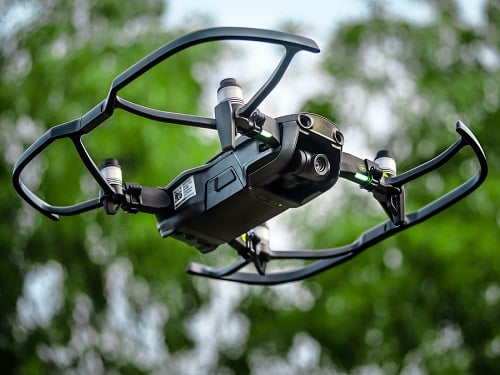Researchers from US Carnegie Mellon University have concluded that quadcopter drones produce much less greenhouse gas emissions than traditional alternatives for last-mile delivery.
The Problem
The point of the research was to shine a light on the energy productivity of freight transportation, which has traditionally been a real challenge in an overwhelmingly petroleum-powered transport sector where medium and heavy trucks (in the US) comprise 24 per cent of transportation energy use. Sadly, this sector creates 37 per cent transportation-related greenhouse gas (GHG) emissions. Also, light-duty vehicles produce 57 per cent of transportation GHG emissions and are responsible for 64 per cent of transportation energy use. Freight transportation is also a large source of nitrogen oxides (NOxs) and other air pollutants.
Research
The researchers compared per package energy consumption of quadcopter drones against diesel and electric medium-duty trucks, small vans, and electric cargo bicycles for last-mile package delivery. The last-mile refers to the last leg of a journey which comprises the movement of the parcel from the transportation hub to the destination / delivery address.
Findings
The researchers found that delivery drones can have up to 94 per cent lower energy consumption per package than other vehicles for last-mile delivery, with only electric cargo bicycles providing lower GHGs/package.
The researchers also found that that the greenhouse gas emissions of package delivery by drone depend on both the total electricity needed for the delivery and the emissions intensity of the regional electricity grid. For example, some areas may be more carbon-intensive or have cleaner grid mixes.
Other Factors
Othe factors to consider when looking at the research results, however, include:
– Restrictions on where commercial drones are allowed to fly over urban areas could mean longer routes and, therefore, more drone energy consumption and GHG emissions per package delivered.
– A small drone that can only carry one package may not be as efficient as another delivery vehicle e.g., an eCargo bike with a trailer that can carry lots of packages in one trip.
– Drones deliver direct to the recipient who comes out to receive the package. Other last-mile delivery modes may require different mixes of activity e.g., having to park, walk, and post a delivery, or climb stairs. This makes comparisons more complicated.
What Does This Mean For Your Business?
Freight currently accounts for a massive amount of transportation energy use, emissions, other dangerous air pollution. The research highlights the point that creative but practical and clean methods of last-mile delivery need to be found to replace the current polluting options such as diesel courier vans. Although the small parcel drones studied compare well per package on green factors and sustainability, the reality is that this would need to scaled up dramatically to realistically be able to deliver the volume of parcels and other freight that are transported on last-mile journeys daily. Electric vehicles may be a more realistic option in the shorter term for cleaner last-mile deliveries although a mix of other options can help in crowded city areas. Delivery robots are another interesting method that’s been trialled in recent years in urban areas, and it is likely that more testing and investment will be focused on drones in the coming years to develop their wider potential.




